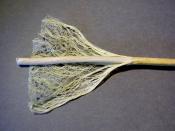A textile is any product made from fibers or yarns which is woven or spun, knitted or non-woven. Textiles are so important because it is a major part of many world economies. Knowing about textiles is essential because of professional knowledge in the workforce. It is also imperative for consumers when shopping.
Textile products have been created prior to written records. It has changed from hand made to machine processing, and from home industries to factory systems.
The performance and care of all textile products depends on four component parts which closely interact. The four major production segments are fiber content, yarn structure, method of construction and dyes, prints, and finishes.
Fibers contribute to a fabrics performance by the combination of a fibers physical structure, chemical structure, molecular structure and performance properties. A fabrics physical structure consists of fiber length, surface and longitudinal configuration. A fiber is either classified as being a staple or filament fiber.
Filament fibers are long and measured in yards or miles. Staple fibers are considered short and measured in inches. A fibers surface or surface contour can be considered to have nodes, scales and striations, serrated or smooth. It varies depending upon whether it is a natural or manufactured fiber. A fibers longitudinal configuration can be classified as being crimped, twisted, coiled or straight.
Fibers are placed into generic groups because of similar chemical compositions. For example, cotton and flax are categorized in the natural cellulosic fiber group due to their comparable chemical compositions. Silk and wool are classified in the natural protein fiber group. In the synthetic fiber group contains nylon and polyester because they are composed of all chemicals. As for rayon and acetate, they are in the regenerated cellulosic manufactured fiber group because they contain some natural components as well as being...


